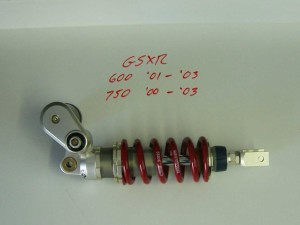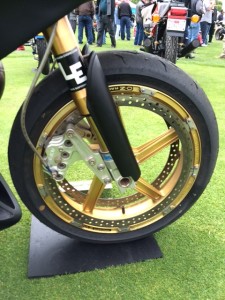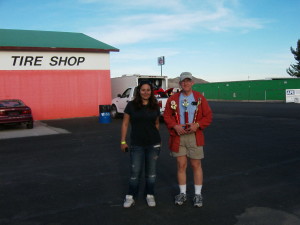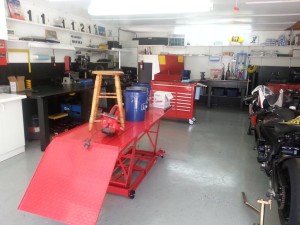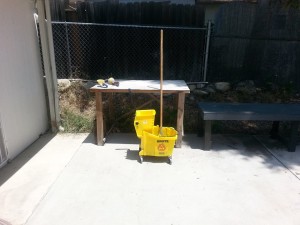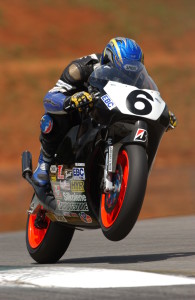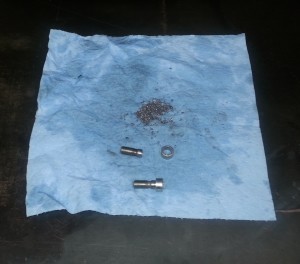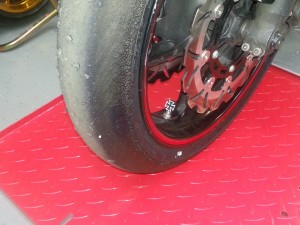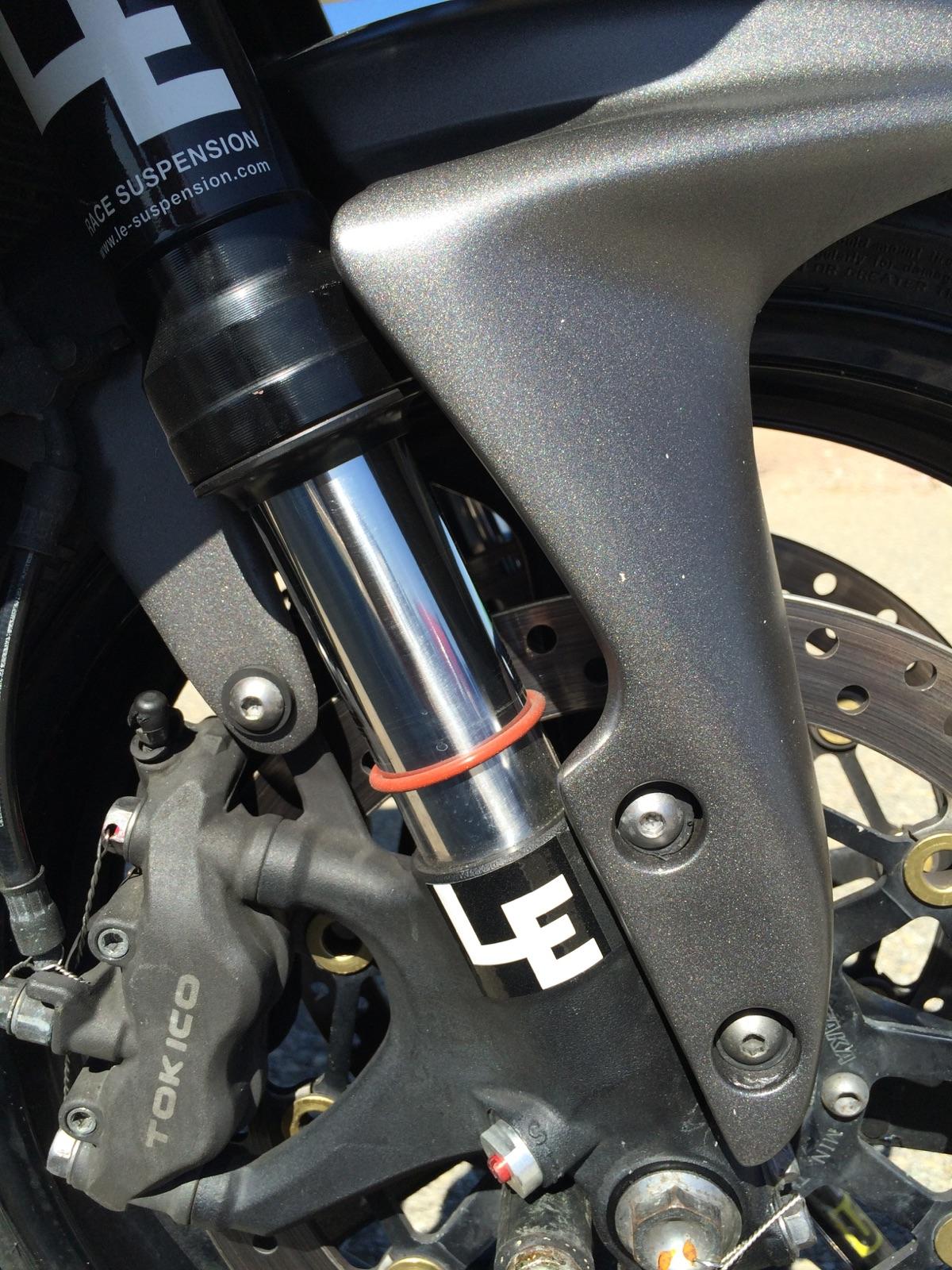WP Shock Clearance
Golf Course
Podcast In Print #3
Point/Counterpoint by Ed Sorbo and Michael Gougis
(Eds. Note: Racers Ed Sorbo and Michael Gougis talk incessantly about motorcycle road racing on the phone and in podcasts. Apparently, that’s not enough, because they also exchange emails on the subject. We’ll publish some of their exchanges.)
What do you mean by “Why?”
Ed Sorbo:
At a recent AHRMA event we shared pit space with Stacie B London. She races an old CB160 and got to the track in an old Ford pick up. Lots of her follow racers also have old pit bikes. I asked if she has something against vehicles that start, idle and have air conditioning. She looked at me like she had never thought of it that way and we got to talking about why we race.
I had been thinking/wondering about racing for a long time but did not do anything about it till the universe gave me a push. Once I was racing the fun captured me till the challenge took over. Part of it is that I can’t quit and it’s a great way to learn useful stuff. Being good at it helps me keep doing it and it long ago became a way to make a living.
Stacie B London;
My 4 wheeled vehicle is a red 1970 Ford F100 Custom, I sold my teal 1992 Ford Ranger XLT to purchase it. My mom couldn’t understand why I went from a perfectly fine 1992 vehicle to an older more “unreliable” version, until she saw it. “Wow that’s cool” were her exact words. Owning my dream truck has not been a bed of roses, but it is fun for all its analogue qualities.
My first car at 16 was a 1970 Plymouth 340-V8 Duster, so I’m used to, and expect, a certain kind of feedback from a vehicle. I’ve driven new cars and I like them just fine, but for me they lack a certain personality. Sure my truck takes a little longer to get places, doesn’t have AC, or a stereo, but those are things I can live with or have adapted to. When it does break, which is not as often as you might think, I can pop the hood and pretty much see everything and diagnose it and within a couple phone calls figure out what is wrong and how to fix it. Its a fun truck to have as it gets attention wherever it goes.
It’s also a conversation starter, which is a pretty great thing in this device-crazed society where everyone is staring into a screen rather than a face having a conversation.
I got into racing a 1968 CB160 because I was invited to the vintage races because my daily rider is a 1969 BMW R60US. I bought this first bike completely by accident or by good fortune and it was the first domino in a series of experiences in the vintage community. When I decided to start riding and looking for my first bike even though I knew nothing about bikes I had a picture of a bike in my head of what I wanted, and I found it in Craigslist add. Because I didn’t know about motorcycles, I also didn’t know about the different communities or sub-cultures and I had no idea what I was getting myself into, I was just following a gut feeling.
As an industrial designer with a Master of Science in Industrial Design, I’ve spent a lot of time and money developing and trusting my instincts, so when I went to see this barely running bike all I saw was a diamond in the rough and there was nothing anyone could say to convince me otherwise. I’ve had it now for six years and its been nothing short of an incredible and wonderful journey that I am so grateful for. This choice has affected and changed everything.
Once I got into racing my 160 its become a project that I can’t let go of until it’s completed. People ask me all the time when I’m going to start racing a bigger bike or a newer bike, and the truth is, I would love to, I just can’t afford to prep and race more than one bike and I’m not done with the 160. It’s like a relationship and I know we have more to do and I have more to learn from it. Sure I could put my time and money into another bike that is newer or larger displacement. But why when I enjoy this one so much? Just like my truck and BMW, the 160 has not only taught me a lot but has also inspired many creative collaborations and to honoring these experiences and education I need to see the project to the end.
Michael Gougis:
Hi Stacie! Always good to hear from you. Your contribution to the SoCal racing scene is far greater than you will ever know.
But let’s talk about me.
My current race bike is that 2002 Yamaha YZF-R1. Race bodywork, windshield from Hong Kong, race tires. That’s it. A slip-on pipe with a Power Commander that may or may not be doing anything. Not just stock suspension, but stock unrebuilt-by-Sorbo suspension. (P.S. The muffler is held on by a bolt that is an inch too long. I leave it there because it makes Ed absolutely crazy every time he sees it.)
Why?
The bike looks spectacular. And it is fast enough and handles well enough to keep me entertained on the racetrack. And I get a great deal of joy from maintaining it, looking at it in the garage, washing it. And I enjoy most of all the fact that it has a tech sticker on it and my racing numbers.
People race for a million reasons. I struggle to get some people to understand that not everyone wants to go racing to become World Champion. I’ve been through that phase where only winning mattered. Now I have a racebike because that makes me a racer. Being a racer forces me to maintain my fitness and organize a race program. And chasing someone else makes me try harder, push my personal barriers, and gives me a reason to enjoy the thrill of twisting the throttle on a machine that makes a Ferrari look Pinto-slow.
In one of my classrooms, there’s a saying on the wall that’s attributed to hockey great Wayne Gretzky – you miss 100 percent of the shots you don’t take. By showing up, I beat everyone who’s sitting on a couch or barstool or posting on the ‘net about how bad-ass they would be if only …
Ed Sorbo:
Better not leave that bike near me unattended again, I have a hacksaw in my tool box, that bolt won’t last long…
I have long known that we all have our own reasons for racing. Sure, there are common threads to each story. I’m sure you, Dear Reader, each related to some part of all these reasons. What I’m learning now is how much and how often our reasons change.
I use to run radio ads promoting the next road race at Hawaii Raceway Park on Radio Free Hawaii. One of the tag lines was, “If it was easy, it would be a video game.” That event was a 4 Hour. I’m not sure what the gamers though of that line but to me it spoke to the challenge of racing that I hope never fades. “See you on Sunday.”
Obsessive Compulsive Order
The Twelve Intangibles Of Racing … #26
Racers Michael Gougis and Ed Sorbo discuss World Superbike, inter-team dynamics and why the new guy on the Kawasaki squad is kicking the snot out of the World Champion who has been with the team for years. Sorbo, a top-level crew chief who’s worked with top-flight riders, offers his insights from the inside. A discussion about sea cucumber ensues, with Gougis and Sorbo in complete agreement that it tastes awful.
Podcast: Play in new window | Download
Breakfast At Sorbo’s Shop #25
In Episode 25 of Deep Thinking, the motorcycle road racing podcast, racers Ed Sorbo and Michael Gougis talk about the MotoGP race at Jerez as Gougis eats breakfast. A discussion ensues over Marc Marquez’ newest and most committed fan, the guy who is hoping against hope that the Honda rider wins the championship – the guy who ran over his finger! A guy named Robert behaves in much the same manner as Sorbo’s cats, in that he makes a cameo appearance at the podcast but refuses to comment.
Podcast: Play in new window | Download
Useful Skill
I started being a mechanic when got my first bicycle but my career as a mechanic started at Castle Park Hawaii working on Go-Karts and Bumper-Boats. Along the way I worked on my motorcycles. Then I got my first motorcycle shop job and soon after, started racing, in ’82.
Growing up in Hawaii, I had to deal with a lot of stuck bolts. There are two fork banjo bolts in this photo. The one at the bottom is intact. It holds the cartridge rod to the bottom of the fork. Both of these were over tightened.
On a side note, torque is not set by how worried you are about how important a bolt is, it’s determined by the strength of the bolt.
Anyway, the top bolt was also rounded out where the Allen wrench goes. Because the bolt is up inside the foot of the fork there is no other way to get a hold of the bolt. My solution was to drill down the center of the bolt, with a hand drill, with larger and larger bits till I removed the head of the bolt from the shaft.
If I can get at the head of the damaged/stuck bolt I have a bunch of tools made to grip the head or the shaft. Another good trick for screw heads is to use a chisel and a small hammer to drive the bolt around.
So far, much like how you never see a cat skeleton up in a tree, I have always found a way to remove stuck bolts.
Righty-tighty. Lefty-loosey.
No Dice
Valve caps with blinking lights, dice or other stuff may look neat as an impulse idea near the cash register but they are just un-sprung spinning mass and worse, to me.
The job of your valve cap is to form an air tight seal so that no air can escape from your tire even when the valve core is forced to open by centrifugal force. I’ve yet to find a seal inside any of these toy caps.
If you still have rubber valve stems you may be surprised to learn that the weight of a toy cap times the rotating speed of the wheel is more than enough to fold the stem over till the cap is pressed against the rim. Do you really want to be folding the thing that keeps the air in your tires?
On my bikes you will only find a properly tightened metal valve cap with a seal inside. You will also find that I have all the air pressure I started with and no extra spinning mass.
How to Adjust your Suspension
The most common suspension adjusters are pre-load, compression and rebound. This is a guide to help you understand what they do.
Springs: Hold up the weight of you and the bike. Think of them as stronger or weaker, not hard or soft.
Pre-load: Only stores energy in a spring, it does not make the spring stronger. More pre-load makes the bike taller only at rest.
Damping: Controls how fast or slow the suspension moves up and down. Think of damping as fast or slow, not hard or soft.
Compression damping controls how fast or slow the suspension gets shorter. Braking, the front of a bump and the start of a turn all compress suspension.
Rebound damping controls how fast or slow the suspension gets taller. Acceleration, the back of a bump and the end of a turn all let the suspension rebound.
Now to turn these ideas into feelings. This is best done at a track day but you can also pick out a mile or so loop with slow and medium speed turns, bumps and smooth bits. Throughout this test you must ride under control and consistently. Crashing is on you.
First ride your loop to set a base. Then ride the same loop with these different changes. You will need to write down what the bike did/how it felt after each ride.
One ride each, set the adjuster back where it was after each test: Forks & shock together. Pre-load out, Pre-load in. Comp out, Comp in. Reb out, Reb in. That’s six rides so far. Now look at your notes. Some changes let the bike move more, some changes make the bike move less. Now you know what they all do and it will be easier for you to find the sweet spot.
Never be afraid to do the wrong thing, you will learn something and you will know to go the other way.
How smart are you? If you make the changes and do the riding, the idea of what you think the bike should do after each change will taint your results. There are six tests here. Ask a friend to make up the order and to repeat two of the tests for a total of eight rides. Now you don’t know what has been changed so your test will yield better data. If you give the same feed back for both of the tests that are repeats you know you are a good test rider. If you don’t, then you need to work on your riding skills. This is your control.
Call me with your questions. If your suspension is stock the changes will be small and sometimes hard to notice. If you have LE suspension the changes will be big and easy to notice.
This is just the beginning. There are many things I left out because you have to start somewhere. The most difficult part is that everything is always changing because the bike is so dynamic.
Work on this Grasshopper and check back here later for the next step.
Reverse Osmosis #24
In Episode 24 of Deep Thinking, the motorcycle road racing (and apparently anything else) podcast, racers Ed Sorbo and Michael Gougis discuss how cool new bike technology requires racers to think about even the simplest of maintenance tasks differently. A discussion ensues about doing tech inspection correctly at the club racing level. Sorbo receives a compliment and is nearly rendered speechless.
Podcast: Play in new window | Download

